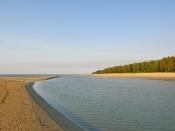An estuary is a coastal area where fresh water from rivers and streams mixes with
salt water from the ocean. Many bays, sounds, and lagoons along coasts are estuaries.
Portions of rivers and streams connected to estuaries are also considered part of the
estuary. The land area from which fresh water drains into the estuary is its watershed.
Estuaries come in all shapes and sizes, each unique to their location and climate. Bays,
sounds, marshes, swamps, inlets, and sloughs are all examples of estuaries.
An estuary is a fascinating place from the largest landscape features to the smallest
microscopic organisms. When viewing an estuary from the air on is practically amazed by
dramatic river bends as freshwater finds its way back to the sea. The vast expanse of
marsh grasses or mudflats extend into calm waters that then follow the curve of an
expansive barrier beach. Wherever there are estuaries, there is a unique beauty.
As rivers
meet the sea, both ocean and land contribute to an ecosystem of specialized plants and
animals.
At high tide, seawater changes estuaries, submerging the plants and flooding creeks,
marshes, panes, mudflats or mangroves, until what once was land is now water.
Throughout the tides, the days and the years, an estuary is cradled between outreaching
headlands and is buttressed on its vulnerable seaward side by fingers of sand or mud.
Estuaries transform with the tides, the incoming waters seemingly bringing back to
life organisms that have sought shelter from their temporary exposure to the non-aquatic
world. As the tides decline, organisms return to their protective postures, receding into
sediments and adjusting to changing temperatures.
The community of life found on the land and in the water includes mammals, birds,
fish, reptiles, shellfish, and plants all interacting within complex food webs. Flocks of
shore birds stilt through the shallows, lunging long bills at their abundant prey of fish,
worms, crabs or clams. Within the sediments, whether mud, sand or rocks, live billions of
microscopic bacteria, a lower level of the food web based largely on decaying plants.
Estuaries are tidally-influenced ecological systems where rivers meet the sea and
fresh water mixes with salt water. Estuaries provide habitat;tens of thousands of birds,
mammals, fish, and other wildlife depend on estuaries. They provide marine organisms,
most commercially valuable fish species included, depend on estuaries at some point
during their development. Where productivity is concerned, a healthy, untended estuary
produces from four to ten times the weight of organic matter produced by a cultivated
corn field of the same size. Estuaries provide water filtration;water draining off the
uplands carries a load of sediments and nutrients. As water flows through salt marsh peat
and the dense mesh of marsh grass blades, much of the sediment and nutrient load is
filtered out. This filtration process creates cleaner and clearer water. Estuaries also
provide flood control. Porous, resilient salt marsh soils and grasses absorb flood waters
and diffuse storm surges. Salt marsh dominated estuaries provide natural buffers between
the land and the ocean. They protect upland organisms as well as billions of dollars of
human real estate.
Estuaries are crucial transition zones between land and water that provide an
environment for lessons in biology, geology, chemistry, physics, history, and social issues.
Estuaries are significant to both marine life and people. They are critical for the survival
of fish, birds, and other wildlife because they provide safe spawning grounds and
nurseries. Marshes and other vegetation in the estuaries protect marine life and water
quality by filtering sediment and pollution. They also provide barriers against damaging
storm waves and floods.
Estuaries also have economic, recreational, and aesthetic value. People love water
sports and visit estuaries to boat, fish, swim, and just enjoy their beauty. As a result, the
economy of many coastal areas is based primarily on the natural beauty and bounty of
their estuaries. Estuaries often have ports serving shipping, transportation, and industry.
Healthy estuaries support profitable, commercial fisheries. In fact, almost 31 percent of
the Gross National Product (GNP) is produced in coastal counties. This relationship
between plants, animals, and humans makes up and estuary's ecosystem. When its
components are in balance, plant and animal life flourishes.
Humans have long been attracted to estuaries. Indian mittens consisting of shellfish
and fish bones are reminders of how ancient cultures lived. Since Colonial times we have
used estuaries and their connecting network of rivers for transporting agricultural goods
for manufacturing and trade. Not only do commercially important fish and shellfish
spawn, nurse, or feed in estuaries, estuaries also feed our hears and minds. Scientists and
even poets and painters are inspired by the beauty and diversity found in an estuary.
Human activity also seriously threatens the vulnerable ecosystems found in the
estuaries. Long considered to be wastelands, estuaries have had their channels dredged,
marshes and tidal flats filled, waters populated, and shorelines reconstructed to
accommodate our housing, transportation, and agriculture needs. As our population
grows and the demands imposed on our natural resources increase, so too does the
importance of protecting these resources for their natural and aesthetic values.
In recognition to these threats, Congress, in 1987, established the National Estuary
Program (NEP) as part of the Clean Water Act. The NEP's mission is to protect and
restore the health of estuaries while supporting economic and recreational activities. To
achieve this, the Environmental Protection Agency (EPA) helps create local NEPs by
developing partnerships between government agencies that oversee estuarine resources
and the people who depend on the estuaries for their livelihood and quality of life. These
groups plan and implement programs according to the needs of their own areas. Local
NEPs are demonstrating practical and innovative ways to revitalize and protect their
estuaries. The benefit of this program is that it brings communities together to decide the
future of their own estuaries.
One specific estuary is the San Francisco Estuary. Human activities in the 1600
square mile Bay/Delta watershed region have drastically altered natural habitats and
impaired the functions of the estuary's ecosystem. Poor cattle grazing practices contribute
to soil erosion and water quality problems. In model public or private partnership, this
NEP is assisting a private rancher in developing a grazing management strategy for a 500
acre parcel of public land within Wildcat Creek Regional Park. Strategies already being
implemented include building barriers to prevent livestock from trampling sensitive
habitats, installing pens to improvelivestock management, and selecting cattle grazing
period to retard the growth of alien and nuisance plants. These measures encourage the
regrowth of native bunchgrasses and fords that provide not only better habitat for wild
life, but also more desirable forage for the cattle. In addition, soil erosion and pollutant
loading should decrease.
Another interesting and problematic estuary is New York-New Jersey Harbor
Estuary. Trash and other foldable marine debris washing up on area beaches had been
chronic problem for the New York-New Jersey Harbor Estuary, but unusual episodes in
1987 and 1988 shocked the public and closed many beaches. The New York-New Jersey
Harbor GNP developed a short-term plan using helicopters and vessels for surveillance
and capture of the foldable debris. Along-term plan to address the floatables problem was
subsequently developed. This included the purchase of additional skimmer vessels to
collect debris, a pollution decrease strategy, and an Operation Clean Shores program in
New Jersey that has already removed 10,000 tons of debris.
There are many estuaries in the United States that are in the NEP. There are also
small estuaries. Such resources include the Mississippi and Alabama estuaries. The
GNP, National Estuary Program's basic purpose is to bring new life to present-day
estuaries.


